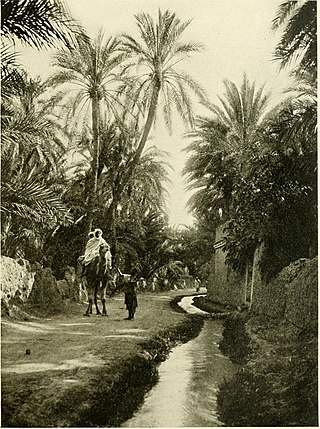
Djelfa is the capital city of Djelfa Province, Algeria and the site of ancient city and former bishopric Fallaba, which remains a Latin catholic titular see.
Drizipara or Druzipara, Drousipara, Drusipara, now Büyükkarıştıran in Lüleburgaz district, was a city and a residential episcopal see in the Roman province of Europa in the civil diocese of Thrace. It is now a titular see of the Catholic Church.

Pupput, also spelled "Putput", "Pudput", "Pulpud" and "Pulpite" in Latin, sometimes located in Souk el-Obiod ou Souk el-Abiod, is a Colonia in the Roman province of Africa which has been equated with an archaeological site in modern Tunisia. It is situated on the coast near the town of Hammamet, between the two wadis of Temad to the north and Moussa to the south. Much of the Pupput is buried under modern holiday developments which have been built over the major part of the site.

Girus Tarasii was a town in the Roman province of Numidia that became a residential episcopal see. It is tentatively identified with ruins situated at what is now called Henchir-Tarsa in Algeria.
Nicives, identifiable with N'Gaous in Batna Province, Algeria, was an ancient Roman town of the Roman province of Numidia.

Vescera, also known as Ad Piscinam, was an ancient titular see and Roman colony in Roman North Africa. It has been identified as a site near Biskra in Algeria. It remains as a titular see of the Roman Catholic Church in the Province of Numidia.
El-Kentour (الكنتور) is a town and mountain in Algeria. It is located in the Constantine Mountains. El-Kentour is also the site of the El-Ouahch to El-Kentour tunnel, which is part of the National Road 3.

Vallitanus or Vallis was an ancient Roman–Berber colonia in Carthage, Tunisia. The town is identified with ruins at Sidi Medien, where are located the remains of a Roman theatre, and a number of Roman inscriptions bearing witness to the town's name, and some local officials of the time can be found near the theatre.

Altiburus was a Roman–Berber town located in Africa Proconsularis. The town is tentatively identified with ruins at Henchir-Medeina in modern Tunisia.
Nova Barbara was a Roman–Berber town in the province of Numidia. It has been tentatively identified with the stone ruins at Beni-Barbar or Henchir-Barbar, Algeria. The Beni-Barbar tribe take its name from this location, though it has been several centuries since it lived there. It was also the seat of an ancient Catholic diocese.

Autenti was a Roman–Berber civitas and bishopric in Africa Proconsularis. It was a diocese of the Roman Catholic Church.

Forontoniana was a Roman town of the Roman province of Byzacena during late antiquity. The town has tentatively been identified with the ruins at Henchir-Bir-El-Menadla in modern Tunisia.

Garriana was a Roman town of the province of Byzacena during late antiquity. The town has tentatively been identified with the ruins at Henchir-El-Garra in modern Tunisia. The name Henchir-El-Garra simply means the Ruins of Garria.
Gunugus or Gunugu was a Berber and Carthaginian town in northwest Africa in antiquity. It passed into Roman control during the Punic Wars and was the site of a colony of veteran soldiers. It survived the Vandals and Byzantines but was destroyed during the Muslim invasion of the area.

Giru Mons is an ancient town of the Roman Empire and a titular bishopric of the Roman Catholic Church. The ancient town has been tentatively identified with ruins at Yerroum, northern Algeria.

Tamada was an ancient Roman–Berber civitas in the province of Mauretania Caesariensis. The town lasted through the Byzantine Empire, Vandal Kingdom and Roman Empire into late antiquity, until at least the Muslim conquest of the Maghreb in the 7th century.
Tuscamia was an ancient Roman-Berber civitas in the province of Mauretania Caesariensis. The town is known from late antiquity having flourished through the Vandal Kingdom and Roman Empire, and possibly through the Muslim conquest of the Maghreb. The exact location of the ancient town is now lost to history, but it was somewhere in today's Algeria.
Sicilibba was an ancient Roman town of the Roman province of proconsular Africa. The ancient town is tentatively identifiable with the ruins at Alaouine in today's Tunisia.

The diocese of Tetci is a suppressed and titular see of the Roman Catholic Church. An exact location of the town is now lost to history but it was in today's Tunisia.

Marazanae was a Roman town of the Roman province of Byzacena during the Roman Empire and into late antiquity.








